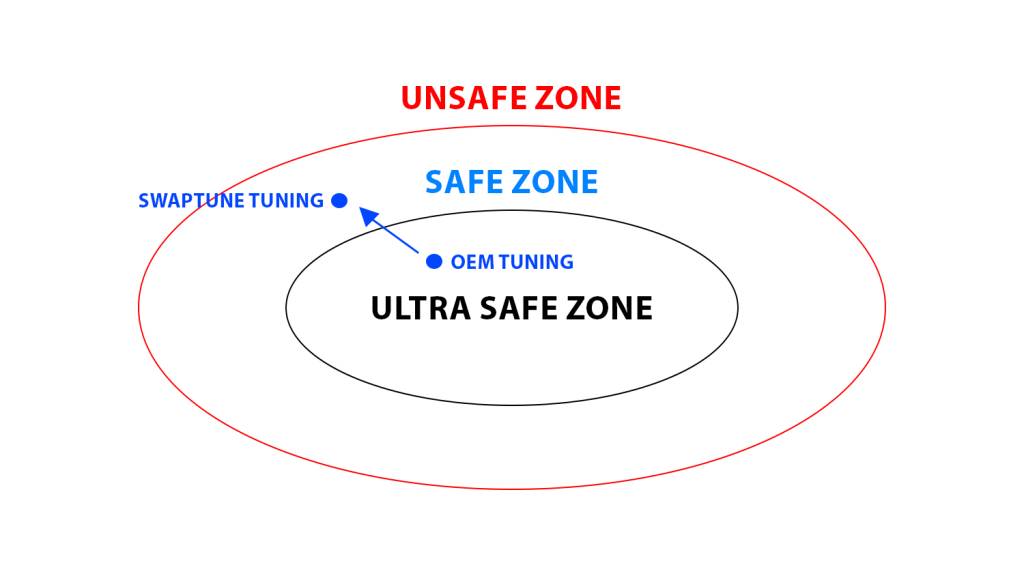1. Introduction to ECU Tuning
ECU tuning consists of modifying the electronic parameters of the engine control unit (ECU) to optimize its performance. This results in increased power and torque, improved driving comfort, and, in some cases, a fuel consumption reduction of up to 10%, particularly on diesel engines.
Thus, a well-executed ECU tuning allows you to get the most out of the engine while respecting its mechanical and electronic tolerances, ensuring optimal reliability without entering the danger zone.
2. Dyno Testing: Useful but Not Essential
A sales argument above all
A dynamometer (dyno) is primarily a measurement tool used to verify whether a tuning file is working correctly and if the performance gains are measurable and quantifiable. However, it is not essential for most ECU tuning procedures and does not add value when a proven development method is already in place.
Dyno testing is useful in two specific cases:
- When developing a tuning file for a brand-new engine and a completely new ECU system.
- For advanced preparations such as Stage 3, where mechanical modifications require very precise adjustments.
3. How Does ECU Tuning Work?
What does a tuner do?
A tuner modifies several fundamental parameters of the engine ECU:
- Increase turbo pressure.
- Increased fuel injection.
- Deactivation or modification of torque and power limiters.
The idea is to optimize performance while remaining within a safe zone. As illustrated in the diagram below:
- Ultra Safe Zone: Original equipment manufacturer (OEM) settings, guaranteeing a very wide safety margin.
- Safe Zone: Properly executed tuning that respects mechanical tolerances.
- Unsafe Zone: Excessive modifications may damage the motor.
Swaptune is in the Safe Zone, guaranteeing a balance between performance and reliability. We optimize without compromising the safety of your engine.

4. How to Ensure a Tuning File Works Without a Dyno?
When a Swaptune partner intervenes, he follows a rigorous protocol:
- Read vehicle fault codes.
- Road test before tuning to check engine condition.
- Application of the tuned file using the Swaptune methodology.
- Test drive after tuning to ensure that the vehicle does not become unsafe.
- Read fault codes after intervention to ensure that no anomalies have occurred.
- Inform the customer if a problem is detected and refuse to proceed if a dyno test is required.
Tuning can sometimes reveal a pre-existing problem on the vehicle. It's not the tuning that causes the fault, but it can bring it to light by putting extra strain on the engine.
5. Why doesn't Swaptune offer Stage 3?
Swaptune guarantees high-quality services thanks to a team of tuners with decades of combined experience. However, we do not offer Stage 3 tuning, as this must be developed and adjusted on a power bench to ensure optimum performance.
When some of our partners have dynamometers, it will then be possible to offer Stage 3 tuning safely. For now, this is not yet the case.
6. Custom ECU Tuning: What Does It Really Mean?
A "custom" ECU tuning does not mean adapting the file based on the vehicle's original logs (except when developing an entirely new map) or according to the vehicle’s original dyno run. Instead, it means that the ECU map is adjusted based on:
- The gearbox.
- Parts installed on the vehicle.
- Vehicle mileage.
Each vehicle has its own specific characteristics, and Swaptune takes these into account to guarantee perfectly adapted tuning.
7. Can tuning cause engine failure?
Tuning can lead to engine failure if it's not carried out correctly. That's why choosing Swaptune is a guarantee of quality: our files are the fruit of years of experience by specialized tuners, guaranteeing reliable and secure optimization.
A vehicle is not infallible and can suffer engine, turbo or other breakdowns, even in its original configuration. If an engine tuning has worked for a year without a problem, it's unlikely to be responsible for a subsequent breakdown.
8. Conclusion
A power bench test is by no means essential for engine tuning. It only serves to repeatedly acquire data and develop new engines. Thanks to a rigorous methodology, experienced tuners and precise verification procedures, Swaptune ensures safe, high-performance tuning.
Finally, it's important to note that the difference measured between dyno runs for the same vehicle stems from the vehicle's physical mechanical micro-differences. What matters most is the methodology and rigor applied during tuning. With Swaptune, you're guaranteed reliable, efficient engine optimization, without compromising on safety!
For further information, please send an e-mail to info@swaptune.eu.
